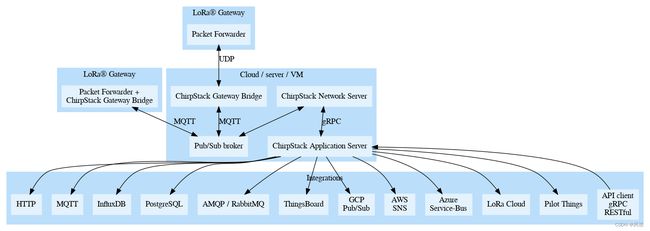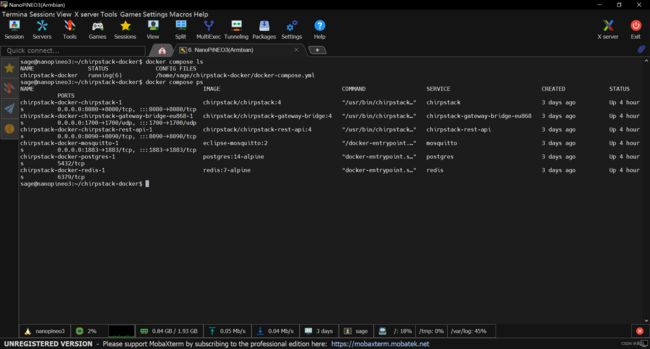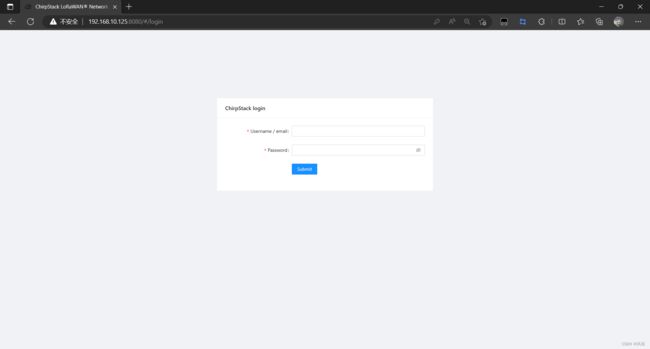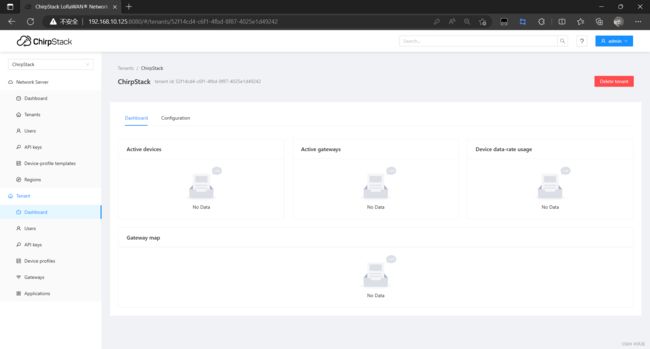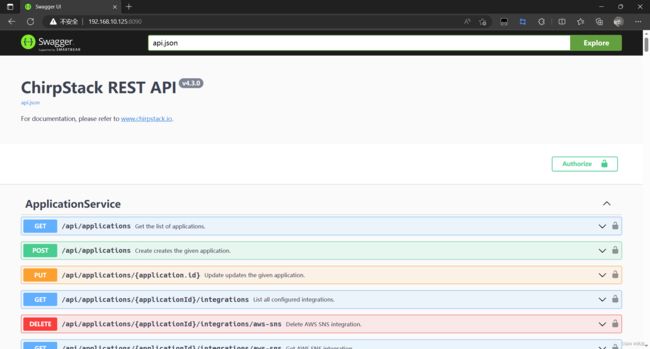LoRaWAN 服务器 ChirpStack 部署教程
ChirpStack 简介
ChirpStack 是一款开源的 LoRaWAN 网络服务器,可用于建立私人或公共 LoRaWAN 网。ChirpStack 为网关、设备和租户的管理提供了一个 web 界面,并与主要的云提供商、数据库和通常用于处理设备数据的服务进行了数据集成,主要的集成服务包括: MQTT 前向转发代理、HTTP 转发代理、influxDB入库服务等。ChirpStack 还提供了基于 gRPC 的 API,可用于集成或扩展 ChirpStacck 的各种功能。
ChirpStack 架构
在架构图中,可以看到 LoRa Gateway 与服务端连接的方式有 2 种。一种是由 Packet Forwarder 直接与 ChirpStack Gateway Bridge 连接,另一种在 LoRa 网关内直接集成了 Packet Forwarder 和 ChirpStack Gateway Bridge 这两个组件,然后与 MQTT Broker 进行连接。
Chirpstack 部署
Chirpstack 部署方式
Chirpstack 可以以 Docker 方式部署,同时,也可以在 Debian/Ubuntu 服务器上单独部署。在 Debian/Ubuntu 服务器上单独部署,需要先安装依赖包,再进行 Chirpstack 的部署,实际操作中,我觉得比较麻烦,下面就一在 Docker 运行的方式进行部署说明。
运行环境
在本教程中,使用友善之臂的 nanopi NEO3 作为核心板作为运行机器。硬件参数如下所示:
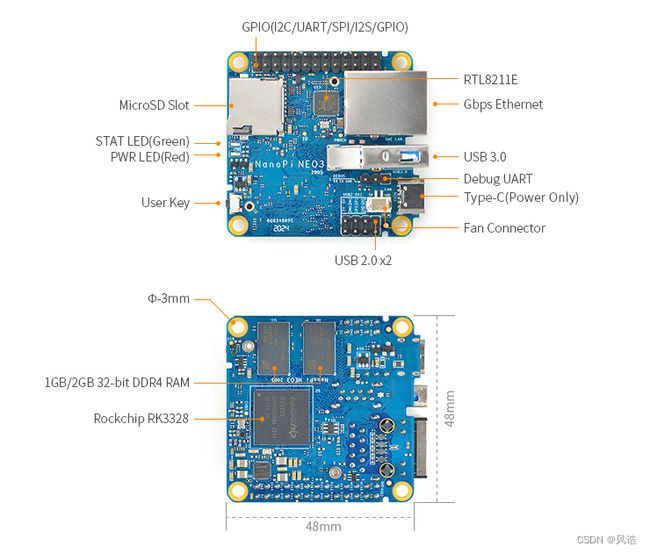
- Soc: RockChip RK3328, Quad-core 64-bit high-performance Cortex A53
- RAM: 1GB/2GB DDR4
- LAN: 10/100/1000M 以太网,带全球唯一MAC地址
- USB Host: 1x USB3.0 Type A and 2x USB2.0 on 2.54mm pin header
- MicroSD Slot: MicroSD x 1 for system boot and storage
- LED: Power LED x 1, System LED x 1
- Key: User Key x 1
- Fan: 2Pin JST ZH 1.5mm Connector for 5V Fan
- GPIO: 2.54mm pitch 26 pin-header, include I2C, UART, SPI, I2S, GPIO
- Serial Debug Port: 2.54mm pitch 3 pin-header, 1500000bps
- Power: 5V/1A, via Type-C or GPIO
- PCB Dimension: 48 x 48mm
- Working Temperature: -20℃ to 70℃
- Weight: 22g
友善之臂官方提供的系统镜像有基于 openwrt 和 ubuntu core 定制过的系统。不过,根据我的个人爱好,Nanopi NEO3 我运行的是 Armbian 系统。
克隆 Github 仓库
Chirpstack 官方提供了一个快速部署 Chirpstack 的 Github 仓库,利用 dockper compose 工具,对 Chirpstack 服务进行快速部署。
git clone https://github.com/chirpstack/chirpstack-docker.git
启动服务
cd chirpstack-docker
docker-compose up -d
查看 docker 运行状态
等待 docker 启动完成后,不改变系统路径,直接在命令行输入:
docker compose ls
命令行返回 compose 启动的情况:
NAME STATUS CONFIG FILES
chirpstack-docker running(6) /home/sage/chirpstack-docker/docker-compose.yml
然后,再查看 docker compose 启动的容器运行情况:
docker compose ps
运行结果如下所示:
访问 Chirpstack 服务
使用 Web 浏览器访问本地的 Nanopi NEO3 的 8080 端口,就可以看见 Chirpstack 的服务登陆页。我的 Nanopi NEO3 地址是 192.168.10.125 所以,我用浏览器直接访问“192.168.10.125:8080”端口后,自动跳转到 Chirpstack 的登陆页。
登陆的用户名和密码默认是: admin/admin,登陆成功后,就可以看到 Chirpstack 的 dashboard 页面了。
访问 Chirpstack 的 Swagger 接口
在浏览器中访问 8090 端口,就可以进入 Chirpstack 的 Swagger 后端接口 API 文档。我这里访问的是 Nanopi NEO3 的局域网地址“192.168.10.125:8090”。
到此,Chirpstack 使用 Docker 的快速部署就完成了。
Chirpstack 配置
chirpstack-docker 目录
从 Github 获取 chirpstack-docker 工程后,可以查看工程的目录结构如下所示:
.
├── configuration
│ ├── chirpstack
│ │ ├── chirpstack.toml
│ │ ├── region_cn470_0.toml
│ │ ├── region_cn470_10.toml
│ │ ├── region_cn470_11.toml
| │ ├── ...
│ │ ├── region_cn779.toml
│ │ ├── region_eu433.toml
│ │ ├── region_eu868.toml
│ ├── chirpstack-gateway-bridge
│ │ └── chirpstack-gateway-bridge.toml
│ ├── mosquitto
│ │ └── mosquitto.conf
│ └── postgresql
│ └── initdb
│ ├── 001-init-chirpstack.sh
│ └── 002-chirpstack_extensions.sh
├── docker-compose.yml
├── LICENSE
├── lorawan-devices
├── Makefile
└── README.md
- configuration: chirpstack 服务配置总目录,目录下分为 chirpstack 、 chirpstack-gateway-bridge 、 mosquitto 和 postgresql 的配置。
- chirpstack:
chirpstack.toml是 chirpstack 的整体配置,region_xxxxx.toml 文件时针对不同地区的 LoRaWAN 参数的网络设置。 - chirpstack-gateway-bridge: chirpstack-gateway-bridge 网关桥的配置文件。
- mosquitto: mqtt 服务中间件的配置目录,具体配置在
mosquitto.conf中进行配置即可。 - postgresql: chirpstack 数据库配置文件目录,默认部署时,可以先不更改配置。
- chirpstack:
- docker-compose.yml: chirpstack 进行 docker 部署时的 docker compose 文件,规定了镜像依赖,docker 网络以及数据持久化的相关信息。
- lorawan-devices: LoRaWAN 设备的存储库。可以通过
make import-lorawan-devices指令将 LoRaWAN 的终端设备导入到 chirpstack 数据库中。
配置示例
chirpstack 在部署时,只需要将 configuration/chirpstack目录下的 chirpstack.toml和 region_xxxxx.toml文件配置好,就可以了。其他的配置,在刚上手的时候,可以先不用管。
先看 chirpstack.toml文件的配置示例:
# Logging.
[logging]
# Log level.
#
# Options are: trace, debug, info, warn error.
level="info"
# PostgreSQL configuration.
[postgresql]
# PostgreSQL DSN.
#
# Format example: postgres://:@/?sslmode=.
#
# SSL mode options:
# * disable - no SSL
# * require - Always SSL (skip verification)
# * verify-ca - Always SSL (verify that the certificate presented by the server was signed by a trusted CA)
# * verify-full - Always SSL (verify that the certification presented by the server was signed by a trusted CA and the server host name matches the one in the certificate)
dsn="postgres://chirpstack:chirpstack@$POSTGRESQL_HOST/chirpstack?sslmode=disable"
# Max open connections.
#
# This sets the max. number of open connections that are allowed in the
# PostgreSQL connection pool.
max_open_connections=10
# Min idle connections.
#
# This sets the min. number of idle connections in the PostgreSQL connection
# pool (0 = equal to max_open_connections).
min_idle_connections=0
# Redis configuration.
[redis]
# Server address or addresses.
#
# Set multiple addresses when connecting to a cluster.
servers=[
"redis://$REDIS_HOST/",
]
# TLS enabled.
tls_enabled=false
# Redis Cluster.
#
# Set this to true when the provided URLs are pointing to a Redis Cluster
# instance.
cluster=false
# Network related configuration.
[network]
# Network identifier (NetID, 3 bytes) encoded as HEX (e.g. 010203).
net_id="000000"
# Enabled regions.
#
# Multiple regions can be enabled simultaneously. Each region must match
# the 'name' parameter of the region configuration in '[[regions]]'.
enabled_regions=[
"as923",
"as923_2",
"as923_3",
"as923_4",
"au915_0",
"cn470_10",
"cn779",
"eu433",
"eu868",
"in865",
"ism2400",
"kr920",
"ru864",
"us915_0",
"us915_1",
]
# API interface configuration.
[api]
# interface:port to bind the API interface to.
bind="0.0.0.0:8080"
# Secret.
#
# This secret is used for generating login and API tokens, make sure this
# is never exposed. Changing this secret will invalidate all login and API
# tokens. The following command can be used to generate a random secret:
# openssl rand -base64 32
secret="you-must-replace-this"
[integration]
enabled=["mqtt"]
[integration.mqtt]
server="tcp://$MQTT_BROKER_HOST:1883/"
json=true
配置说明
chirpstack.toml文件中的配置主要有以下几项:
- logging: 配置日志等级,可配置为 trace, debug, info, warn, error 其中某一项的值。
- postgresql: chirpstack 连接 postgresql 的参数,包括用户名、密码、最大连接数等。
- redis: chirpstack 的 redis 缓存地址等配置。
- network: 网络服务器总体配置,配置内容包括网络编号,可用的 regions 参数等。(regions 参数是根据各地区的无线电组织划分的专用频段来设定的,在使用时应该遵循所在地区的无线电使用规范)。
- api: chirpstack 接口和秘钥的配置。
- integration: chirpstack 的插件配置,使用时根据需要进行启用,学习是使用默认配置。
地区参数配置示例
# This file contains an example CN470 example (channels 0-7).
[[regions]]
# Name is an use-defined identifier for this region.
name="cn470_0"
# Common-name refers to the common-name of this region as defined by
# the LoRa Alliance.
common_name="CN470"
# Gateway configuration.
[regions.gateway]
# Force gateways as private.
#
# If enabled, gateways can only be used by devices under the same tenant.
force_gws_private=false
# Gateway backend configuration.
[regions.gateway.backend]
# The enabled backend type.
enabled="mqtt"
# MQTT configuration.
[regions.gateway.backend.mqtt]
# Event topic template.
event_topic="cn470_0/gateway/+/event/+"
# Command topic template.
command_topic="cn470_0/gateway/{{ gateway_id }}/command/{{ command }}"
# MQTT server (e.g. scheme://host:port where scheme is tcp, ssl or ws)
server="tcp://$MQTT_BROKER_HOST:1883"
# Connect with the given username (optional)
username=""
# Connect with the given password (optional)
password=""
# Quality of service level
#
# 0: at most once
# 1: at least once
# 2: exactly once
#
# Note: an increase of this value will decrease the performance.
# For more information: https://www.hivemq.com/blog/mqtt-essentials-part-6-mqtt-quality-of-service-levels
qos=0
# Clean session
#
# Set the "clean session" flag in the connect message when this client
# connects to an MQTT broker. By setting this flag you are indicating
# that no messages saved by the broker for this client should be delivered.
clean_session=false
# Client ID
#
# Set the client id to be used by this client when connecting to the MQTT
# broker. A client id must be no longer than 23 characters. If left blank,
# a random id will be generated by ChirpStack.
client_id=""
# CA certificate file (optional)
#
# Use this when setting up a secure connection (when server uses ssl://...)
# but the certificate used by the server is not trusted by any CA certificate
# on the server (e.g. when self generated).
ca_cert=""
# TLS certificate file (optional)
tls_cert=""
# TLS key file (optional)
tls_key=""
# Gateway channel configuration.
#
# Note: this configuration is only used in case the gateway is using the
# ChirpStack Concentratord daemon. In any other case, this configuration
# is ignored.
[[regions.gateway.channels]]
frequency=470300000
bandwidth=125000
modulation="LORA"
spreading_factors=[7, 8, 9, 10, 11, 12]
[[regions.gateway.channels]]
frequency=470500000
bandwidth=125000
modulation="LORA"
spreading_factors=[7, 8, 9, 10, 11, 12]
[[regions.gateway.channels]]
frequency=470700000
bandwidth=125000
modulation="LORA"
spreading_factors=[7, 8, 9, 10, 11, 12]
[[regions.gateway.channels]]
frequency=470900000
bandwidth=125000
modulation="LORA"
spreading_factors=[7, 8, 9, 10, 11, 12]
[[regions.gateway.channels]]
frequency=471100000
bandwidth=125000
modulation="LORA"
spreading_factors=[7, 8, 9, 10, 11, 12]
[[regions.gateway.channels]]
frequency=471300000
bandwidth=125000
modulation="LORA"
spreading_factors=[7, 8, 9, 10, 11, 12]
[[regions.gateway.channels]]
frequency=471500000
bandwidth=125000
modulation="LORA"
spreading_factors=[7, 8, 9, 10, 11, 12]
[[regions.gateway.channels]]
frequency=471700000
bandwidth=125000
modulation="LORA"
spreading_factors=[7, 8, 9, 10, 11, 12]
# Region specific network configuration.
[regions.network]
# Installation margin (dB) used by the ADR engine.
#
# A higher number means that the network-server will keep more margin,
# resulting in a lower data-rate but decreasing the chance that the
# device gets disconnected because it is unable to reach one of the
# surrounded gateways.
installation_margin=10
# RX window (Class-A).
#
# Set this to:
# 0: RX1 / RX2
# 1: RX1 only
# 2: RX2 only
rx_window=0
# RX1 delay (1 - 15 seconds).
rx1_delay=1
# RX1 data-rate offset
rx1_dr_offset=0
# RX2 data-rate
rx2_dr=0
# RX2 frequency (Hz)
rx2_frequency=505300000
# Prefer RX2 on RX1 data-rate less than.
#
# Prefer RX2 over RX1 based on the RX1 data-rate. When the RX1 data-rate
# is smaller than the configured value, then the Network Server will
# first try to schedule the downlink for RX2, failing that (e.g. the gateway
# has already a payload scheduled at the RX2 timing) it will try RX1.
rx2_prefer_on_rx1_dr_lt=0
# Prefer RX2 on link budget.
#
# When the link-budget is better for RX2 than for RX1, the Network Server will first
# try to schedule the downlink in RX2, failing that it will try RX1.
rx2_prefer_on_link_budget=false
# Downlink TX Power (dBm)
#
# When set to -1, the downlink TX Power from the configured band will
# be used.
#
# Please consult the LoRaWAN Regional Parameters and local regulations
# for valid and legal options. Note that the configured TX Power must be
# supported by your gateway(s).
downlink_tx_power=-1
# ADR is disabled.
adr_disabled=false
# Minimum data-rate.
min_dr=0
# Maximum data-rate.
max_dr=5
# Enabled uplink channels.
#
# Use this when ony a sub-set of the by default enabled channels are being
# used. For example when only using the first 8 channels of the US band.
# Note: when left blank / empty array, all channels will be enabled.
enabled_uplink_channels=[0, 1, 2, 3, 4, 5, 6, 7]
# Rejoin-request configuration (LoRaWAN 1.1)
[regions.network.rejoin_request]
# Request devices to periodically send rejoin-requests.
enabled=false
# The device must send a rejoin-request type 0 at least every 2^(max_count_n + 4)
# uplink messages. Valid values are 0 to 15.
max_count_n=0
# The device must send a rejoin-request type 0 at least every 2^(max_time_n + 10)
# seconds. Valid values are 0 to 15.
#
# 0 = roughly 17 minutes
# 15 = about 1 year
max_time_n=0
# Class-B configuration.
[regions.network.class_b]
# Ping-slot data-rate.
ping_slot_dr=0
# Ping-slot frequency (Hz)
#
# set this to 0 to use the default frequency plan for the configured region
# (which could be frequency hopping).
ping_slot_frequency=0
地区参数配置说明
region_cn470_0.toml文件中的配置主要有以下几项:
- regions.gateway: 网关参数配置
- regions.gateway.backend: 网关接入后台的配置(后续会对网关后台接入再详细说明)。
- regions.gateway.channels: 网关用到的无线电频率详细配置(具体参数参考 LoRaWAN 的地区规范)。
- regions.network: 地区网络配置
- regions.network.rejoin_request: LoRaWAN 入网请求。
y.channels: 网关用到的无线电频率详细配置(具体参数参考 LoRaWAN 的地区规范)。
- regions.network.rejoin_request: LoRaWAN 入网请求。
- regions.network: 地区网络配置
- regions.network.rejoin_request: LoRaWAN 入网请求。
- regions.network.class_b: LoRaWAN B 类终端参数配置。
